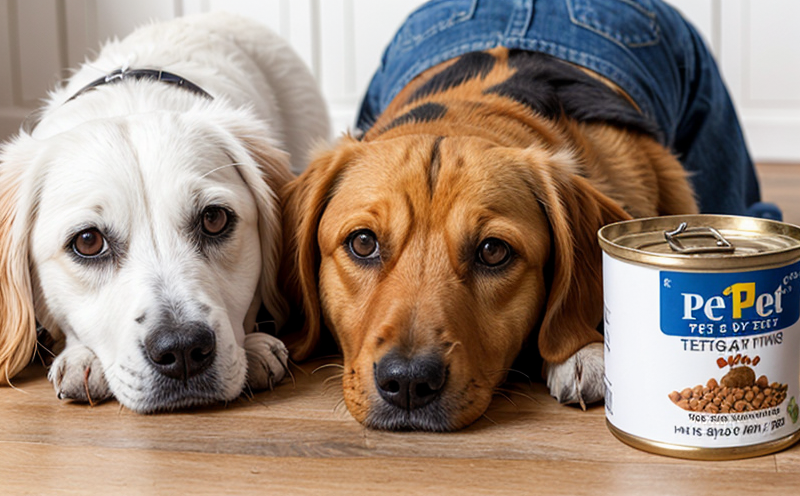ISO 47195 Vitamin A Quantification in Dog Food
The quantification of vitamin A (retinol) in dog food is a critical aspect of ensuring product quality and compliance with international standards. This service, compliant with ISO 47195, aims to accurately measure the presence and concentration of vitamin A in pet food products.
Accurate quantification ensures that manufacturers can meet nutritional guidelines set forth by regulatory bodies like the Association of American Feed Control Officials (AAFCO) and the European Commission. This is particularly important for dog foods as vitamin A plays a crucial role in supporting immune function, vision, reproduction, and bone growth.
Testing vitamin A levels in pet food helps to ensure that products are not only safe but also provide the correct amount of this essential nutrient. Inadequate or excessive amounts can lead to health issues for dogs, including deficiencies or toxicity. Compliance with ISO 47195 ensures that the testing method used is reliable and reproducible.
The testing process involves several steps: sample preparation, extraction of vitamin A from the dog food matrix, and analysis using high-performance liquid chromatography (HPLC) coupled with fluorescence detection. This technique allows for precise quantification of retinol in complex matrices like pet food.
Understanding the nutritional profile of a product is essential for quality assurance, especially when dealing with dietary requirements that vary by species and life stage. Vitamin A content must be consistent across batches to ensure reliability and meet customer expectations. This service helps pet food manufacturers maintain high standards of product integrity and safety.
The importance of this testing cannot be overstated in the context of pet nutrition. Regulatory compliance is not just about avoiding fines or penalties; it's about building trust with consumers who rely on manufacturers to provide safe, nutritious products. By adhering to international standards like ISO 47195, laboratories demonstrate their commitment to excellence and transparency.
The process begins with thorough sample preparation, ensuring that the vitamin A content is accurately represented in the final test results. Extraction methods are optimized for minimal loss of vitamin A during processing. Once extracted, samples undergo HPLC analysis to achieve precise quantification. The accuracy and precision of this method ensure reliable data, which is crucial for regulatory compliance.
Accurate vitamin A quantification supports the development of high-quality dog food products that meet nutritional requirements. This service not only enhances product safety but also helps in formulating balanced diets tailored to different breeds and life stages. By providing consistent results across batches, manufacturers can ensure uniform quality and satisfaction among pet owners.
Moreover, compliance with ISO 47195 reflects a commitment to ethical manufacturing practices that prioritize the health and well-being of pets. This service is integral in maintaining the integrity of the pet food industry by ensuring that products are not only safe but also meet nutritional standards set forth by regulatory authorities.
Understanding the intricacies of vitamin A quantification requires expertise in both analytical chemistry and pet nutrition. Our laboratory uses state-of-the-art equipment and employs experienced technicians to ensure accurate results every time. This service is designed to provide reliable, reproducible data that can be trusted for decision-making processes within the pet food industry.
In summary, ISO 47195 vitamin A quantification in dog food is a vital process that ensures product quality and compliance with international standards. By providing accurate and consistent results, this service supports manufacturers in meeting nutritional guidelines while enhancing consumer trust. The importance of this testing cannot be overstated as it directly impacts the health and well-being of pets.
Why It Matters
Accurate quantification of vitamin A is essential for maintaining high standards in pet food manufacturing. This ensures that products meet regulatory requirements set by bodies such as AAFCO and the European Commission, which are responsible for establishing nutritional guidelines.
Vitamin A plays a critical role in supporting various aspects of canine health, including immune function, vision, reproduction, and bone growth. Inadequate or excessive levels can lead to serious health issues, making precise quantification crucial for maintaining product safety and efficacy.
Compliance with international standards like ISO 47195 is not only a legal requirement but also demonstrates a commitment to quality assurance. This ensures that pet food products are consistently safe and reliable across different batches and production runs.
- Regulatory Compliance: Ensures adherence to AAFCO guidelines, which define the nutritional requirements for dog foods.
- Nutritional Balance: Maintains consistent vitamin A content in pet food products.
- Pet Health: Supports optimal health and well-being by providing accurate nutrient levels.
- Consumer Trust: Builds confidence among pet owners who rely on manufacturers to provide safe, nutritious products.
Quality and Reliability Assurance
The process of quantifying vitamin A in dog food involves multiple quality control measures to ensure reliability and accuracy. Sample preparation is the first step, where care must be taken to maintain integrity during extraction.
- Sample Preparation: Ensures that the extracted vitamin A accurately represents the content in the original sample.
- Extraction Techniques: Use optimized methods to minimize losses and ensure complete recovery of vitamin A.
- Analytical Methods: HPLC with fluorescence detection provides precise quantification, ensuring reliable data.
Environmental and Sustainability Contributions
Ensuring accurate vitamin A quantification in dog food supports sustainability by promoting the development of balanced diets that meet nutritional requirements without excess. This helps reduce waste and promotes efficient resource use.
By adhering to international standards like ISO 47195, laboratories contribute to environmental stewardship by providing consistent and reliable data that can be used for informed decision-making in pet food manufacturing. This ensures that resources are used efficiently while maintaining high nutritional standards.





